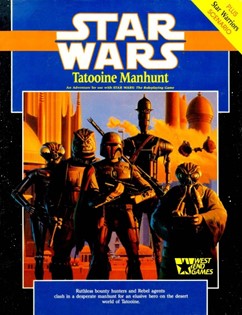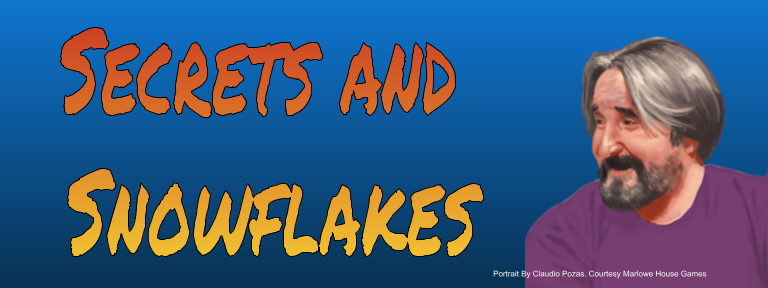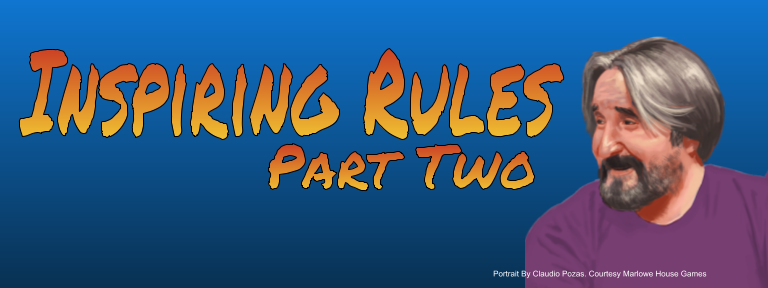Beyond the Heist
The narrative structure of RPGs is pretty universal. Everything that happens is from the PCs point of view and everything happens pretty much in chronological order, but as Ryan and Perram discussed on the last Know Direction, it doesn’t have to always be that way. Ryan was talking about how in the Hells Rebels campaign their planning session turned into a sort of heist montage. Plan X Event, jump to later executing X Event then return to the past and the planning session moving on to Y Event, and so on. But, the heist montage isn’t the only way you can change the narrative in Pathfinder. There are a number of simple tricks that if used sparingly can keep your campaign fresh and your players invested.
Spoiler Warning: This Week’s Blog has Minor Spoilers for the 1988 Star Wars Module, Tatooine Manhunt, Chapter Three of Rise of the Runelords, and Chapter Two of Giantslayer. I’ve tried to keep the spoilers away from major revelations but read at your own risk. Cover images are posted next to the portions of the article that include said spoilers.
1—GM Cut-Away Scenes
The old d6 Star Wars RPG made extensive use of cut-away scenes most often to show what the villains were up to. In the 1988 adventure, Tatooine Manhunt, time is of the essence according to the data the PC’s receive initially they’ll have five days to complete their mission as the Imperial forces make repairs to the Star Destroyer that is docked in the vicinity. Unfortunately, for the PCs once the events get rolling the Empire’s techs and mechanics work overtime to get the ship repaired in four days. To ramp up the player’s suspense and sense of urgency this fact it delivered in a quick cut-away scene narrated by the GM on day three:
Copyright 1988 West End Games
EXTERIOR: SPACECRAFT IN SPACE. The Imperial Star Destroyer Relentless, docked with Kwenn Space Station.
INTERIOR: IMPERIAL STAR DESTROYER—BRIDGE. Captain Parlan stands upon the command platform, watching the space station through bridge viewports. A lower officer steps up and clears his throat.
“Speak,” order’s Parlan.
“The crews have worked through the night and all systems have been repaired.” Snaps the officer. “In addition, Astrogation has calculated an optimum hyperspace route that will get us to Tatooine by tomorrow evening.”
Parlan’s eyes sparkle and his lip turns up in an evil smile. “Then Tallon’s mine! Order immediate departure.”
Fade to . . .
EXTERIOR: THE TATOOINE DESERT
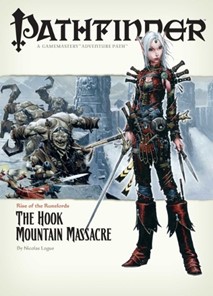
Copyright 2007 Paizo Inc.
I’ve always really appreciated this scene because it wasn’t only a peek at what the villains were up to but it set up for the player’s that the GM wasn’t cheating or hadn’t misled them maliciously about the amount of time they would have. Instead, it presents a logical and troubling turn of events that should worry the players, if not the characters.
With a little planning, scenes like this can be utilized in both published adventures and homebrew campaigns. Feel free to draw attention to distant allies, as well as enemies, or even total strangers who are about to have an impact on the PCs. Consider the following paragraph from Nicolas Logue’s The Hook Mountain Massacre.
“By now, the villagers know the heroes not only laid low “those damnable Grauls,” but also liberated and reclaimed Fort Rannick. When the flood strikes, people begin evacuating at once, but the water’s rise rapidly. Soon after the flooding begins, a villager (a hunter named Bran Fered) rides hellbent up the road north as the banks of the Skull River rise ever higher, threatening to swamp the bridge and road in hours. His report to the PCs is panicked and breathless.”
This single paragraph offers the GM a view of what’s happening in Turtleback Ferry and with only a little work a GM could plan a cutscene that lends weight to Bran’s report of events. Before the box text that follows the above paragraph you could change the point-of-view from the PCs to Bran Fered show some of the flooding as he helps his neighbors out of immediate danger then jumps on his horse and his hellbent ride north to the PCs.
I just recently started listening to the Big Finish Audio Dramas for Pathfinder, specifically, the series based on the Mummy’s Mask AP. The first episode offers a good example of how to do villain cut-aways without giving away too much information.
2—Player Involved Cut-Away Scenes
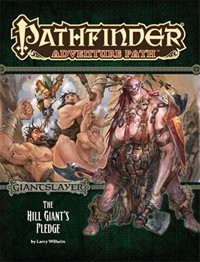
Copyright 2015 Paizo Inc
Another kind of cut-away scene has the players donning different roles for a time, usually no longer than a single session but often as short as a single scene. A great example of this from popular television includes Supernatural and the myriad police procedural shows. Each typically begins with a vignette from the POV of the victim just before they turn up dead. Then, after the opening credits, the heroes show up to begin the investigation. You can use this same technique in your own campaigns and it doesn’t have to be part of a mystery, although running it as a part of the mystery can be interesting because it can give the player’s clues and hints that can help make their characters look more competent. You just have to be careful to not give up too much information.
You can also use this technique to introduce long-running NPCs sometimes well in advance of their arrival. An example of this from the AP line originates in the second book of the adventure path, The Hill Giant’s Pledge. About midway through the module, the PCs are introduced to a pair of dwarf siblings with a rather tragic storyline. Ingrahild and Umlo Nargrymkin entered Ghostlight Marsh in search of an ancestor’s tomb. The pair with their hired mercenaries run afoul of a hag coven. The mercenaries are killed and the siblings are driven mad and separated. A GM could run much of the exploration of Ghostlight Marsh with the PCs in the rolls of the Dwarves and their mercenaries ending the story with the revelation of the hags as a cliffhanger.
I think the ideal time to run this scene would be between books one and two or if Ingrahild survives long enough to tell the PC’s her story a GM could run it as a flashback there.
On TV and in movies, Flashbacks are often filmed with different filters to make them stand out from the current timeline. The TV show Suits makes heavy use of this technique because it regularly uses flashbacks. The flashback sequences all have this green tint to them that isn’t distracting but does set them starkly apart visually from the current events. For those groups really wanting to experiment with making flashback scenes feel different from the main line of the campaign, you don’t have to run those scenes in Pathfinder.
Using the previous example you might use a more narrative RPG such as Dread to focus on the horror aspects of a doomed expedition into Ghostlight Marsh. Alternatively, maybe your PCs have encountered an ancient ruin with pictograms on the walls that tell a particular story from the past. Rather than just relaying it, maybe, you run it in a previous edition of the game. Whether it’s Ancient Thassilon, Azlant, or Old Osirion, nothing says old days and long ago like Thac0 and negative armor classes.
3—Memories
Memories can be full flashbacks you run with a PC or two playing an earlier version of themselves for a scene or two (usually based on their backstory) to give clues to the current encounter. Most often though, you’ll just use it as a narrative tool reminding players of things they either wrote into their backstory or events from earlier in the campaign. One example comes from an early episode of the Glass Cannon Podcast when Lorc, the PC Ranger, is getting his animal companion. The then unnamed wolverine is nearly killed by a party ally as unwanted vermin but the Lorc is able to save the animal first. The scene has a lot more emotional weight than you typically get from “My ranger goes up a level and I get a companion,” because GM paralleled the scene to a previous scene and narrated the memory. Earlier in the campaign, Lorc was helpless to protect someone in a similar situation so this small moment of redemption cements the pair’s ongoing relationship.
When using this technique try to avoid telling the player what their character feels instead focus on the events they remember and how they synch-up with what’s happening now. Remember too that memories can be funny things they often bring familiar odors or sounds and not always in a logical order. A PC trying to figure out a word puzzle who has successfully made a Linguistics check to decipher it might first remember a phantom tune that slowly becomes more coherently the song their father whistled while he thought through a problem. As the tune rattles around in her head the character remembers her father’s advice in his voice and can try to apply what she knows or maybe the song itself has the answer in lyrics he would sing to her as a child.
4—In Media Res
As you start the next portion of your campaign, or a brand new campaign consider jumping straight to the action. If your player’s trust you, it can be very satisfying to begin a new chapter with the briefest of introductions and those three magical words, “Roll for Initiative!” Some adventures have this format hardwired in. Book one of Rise of the Runelords starts with this kind of action but you don’t always get so lucky with the material, or if you are running a strictly homebrew campaign. In those cases, you may need to do a bit more planning to use this technique. Many published adventures have events that occur early in the narrative that will happen regardless of the PC’s choices. Maybe there is a specific dungeon to explore. Nothing says you can’t start your adventure several rooms into the dungeon with the blood of an earlier (easy) encounter still dripping from the fighter’s sword.
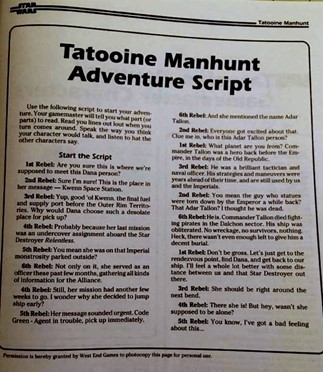
Copyright West End Games
Now a GM could just summarize quickly how the PCs arrived in their current predicament or you could write a short introductory script to get the players talking and getting the information across. The script trick originates (at least to my knowledge) with the d6 Star Wars system and I think I under-utilized it when I first ran Star Wars years ago. The opening scripts were often a little hokey and that turned off younger me, but players could (and should) personalize and improvise a little to polish off some of the dialog’s rough edges. The important part is that scripting the prologue involves the players in the introduction and puts the PCs at the center of the action immediately.
If you are feeling particularly daring you could pick a dungeon or event a little further into the story and let the PCs start at 2nd or 3rd level. Then flashback to how they got into the dungeon running those scenes with the same characters. In this case, for simplicity, you might just use the initial character builds but with one or two negative levels applied. These negative levels would not be the result of damage and not subject to healing. Instead, the character’s work them off by earning XP and advancing. My recommendation is to preserve the integrity of the timeline, rather than killing characters let PCs automatically stabilize at 0 hp. This safety net only lasts until the character’s catch back up to current events although you could impose a lasting scar or flaw for anyone who reaches negative Con during this period.
5—Whack-a-Doo Campaign Ideas
Maybe you’re ready to go all Cloud Atlas and run a multi-generational and multi-verse campaign. Instead of playing through one world-changing event you advance the party through a campaign that grows the immortal soul. Each player takes on the role of one spirit through many lifetimes. A given adventure could happen at any time. Parts of each adventure might happen in different timelines . . . and game systems. If a GM uses Golarion as the base world AD&D could be ancient times (as I talked about above), 3.5 the recent past maybe up until Aroden’s death, Pathfinder the contemporary timeline, and Starfinder the distant future. Maybe you slip in d20 Modern and 5e as Golarion’s 20th century analog and an alternate reality respectively. Or maybe the campaign follows celestial PCs as they handle necessary events over the millennia and the bulk of the action takes place in Starfinder with relevant flashbacks taking the characters to various times in history.
So while most of Pathfinder is played in chronological order and from the heroes point of view it doesn’t have to be. Hopefully, a few GMs will get out there and shake up their campaigns by experimenting with time, point of view maybe even varying the game system when the occasion calls for it. If you have any other GM tips for messing with time and point of view post them in the comments.
We’ll be back in two weeks with more GM tips as I interview a panel of rock star GMs about what makes their games tick.


